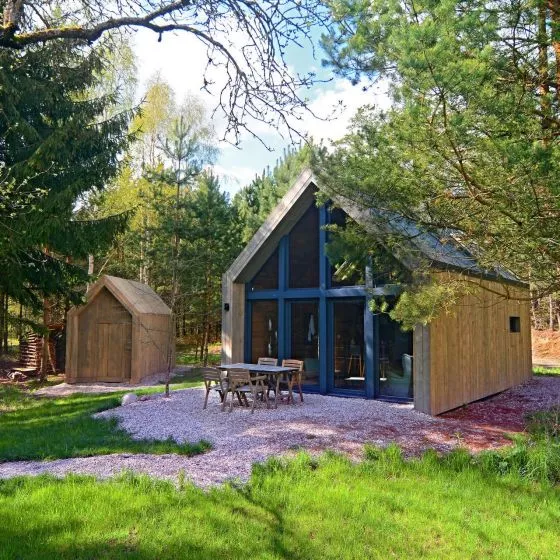The tourist and service complex designed by architects from the 2H+ studio is located near Warsaw, in the village of Wola Rasztowska. According to the assumption, it is to be a space of rest and recreation among greenery for residents of the capital.
bird's eye view
© 2H+ Architects
Surrounded by greenery, the development area has been divided into functional zones connected by paths: sports (with an outdoor gym, tennis courts, a bicycle track, a toboggan run and health paths), a zone for the youngest with a playground, a zone for young people with a rope park and mini golf, a recreation zone and a forest nursery.
In the central part of the area, to the west, are located three buildings from the 1950s - a two-story building with a palatial character and two one-story buildings with an economic function. The location of the new development was determined in accordance with the guidelines of the Local Land Use Plan - the existing buildings (reconstructed and expanded) were supplemented with two additional buildings.
site development plan
© 2H+ Architects
Building A with a service function was intended as a tourist information and nature study center. The existing building was expanded with an additional floor. To enhance the historic character of the facade, according to the architects, the superstructure was designed minimalistically, as a glass "box." The superstructure's superstructure floor will house exhibition space. The expansion of the other existing buildings - Building B, where a banquet hall, training rooms and a restaurant are planned, and Building C, intended for a swimming pool, were solved in a similar way. The development of the complex is complemented by a new building D with an underground garage, which on the first floor accommodates a restaurant, cafeteria, and multipurpose room, and on the upper floors a hotel center. Building E, on the other hand, with service spaces located on the first floor, houses a hostel on the upper floors.
site plan and axonometrics
© 2H+ Architects
Ola Kloc: What was the priority for the developer?
Łukasz Homan: The property is located in the central part of Wola Rasztowska, in the Klembów municipality, about 35 kilometers from Warsaw. For the investor, the most important thing was to design a place that would attract the residents of the capital, which could become a green enclave, helping to get away from the rush and routine of everyday life.
In the new hotel and tourist complex, you can feel as if you are in the heart of a dense forest. Numerous tourist and sports activities, as well as educational activities related to communing with nature, are planned throughout the area.
One of the most important guidelines was the preservation of buildings from the 1950s with facades of historicizing character, at the same time it was important to give them a new interesting function.
Sketch, elevation scheme of existing and new buildings
© 2H+ Architects
Ola: What was the biggest challenge in this project?
Lukasz: The biggest challenge was how to relate the existing buildings to the newly designed buildings. The existing buildings were already imposing their character, which we didn't want to change but more to expose, so that the history and past of the place could be felt. Despite the large site of almost 35.6 hectares, the local plan allowed for the development of only part of the plots, which we developed almost to the maximum (as much as possible). With such an intensity of development, we proposed new buildings, which will be quite different from the existing ones, but we introduced a repetitive element of elevation, which was found on both the new and older buildings.
Ola: The facades are planned to use sheet metal reflecting the surroundings, wood and glass, what made you choose such materials?
Lukasz: On part of the facades of both existing and newly designed buildings, we introduced an analogous solution, which allowed us to integrate and unify the development. The superstructure of the existing buildings was glazed and wooden arcades were introduced. The same solution was introduced in the first floors of the new buildings. The glazing allows a view of the surrounding area (from different levels). Another material on the facade is polished steel sheet, which reflects the surroundings. This solution allows the development to blend in with the dense greenery, and in perception the buildings will be lighter.
elaborated:{tag:AuthorAiB}











































